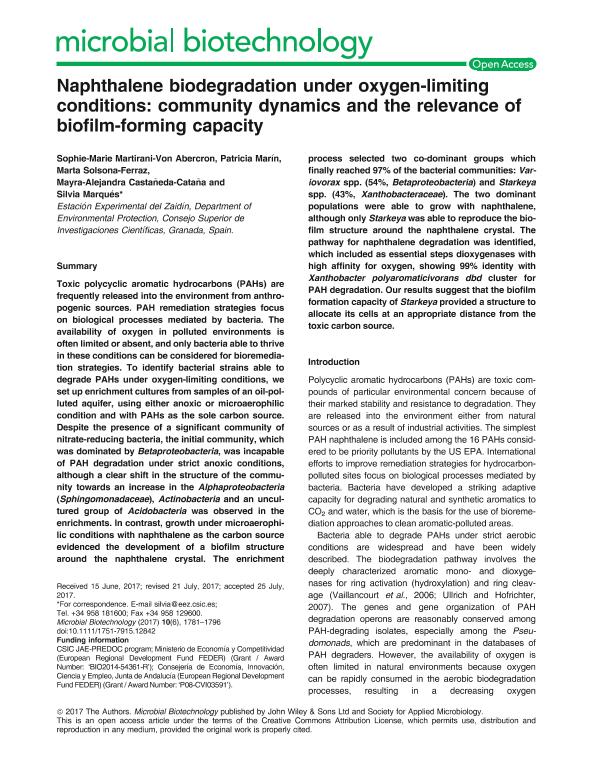Mostrar el registro sencillo del ítem
dc.contributor.author
Martirani Von Abercron, Sophie Marie
dc.contributor.author
Marín, Patricia
dc.contributor.author
Solsona Ferraz, Marta
dc.contributor.author
Castañeda Cataña, Mayra Alejandra

dc.contributor.author
Marqués, Silvia
dc.date.available
2022-12-13T15:56:17Z
dc.date.issued
2017-08
dc.identifier.citation
Martirani Von Abercron, Sophie Marie; Marín, Patricia; Solsona Ferraz, Marta; Castañeda Cataña, Mayra Alejandra; Marqués, Silvia; Naphthalene biodegradation under oxygen-limiting conditions: community dynamics and the relevance of biofilm-forming capacity; John Wiley & Sons Ltd; Microbial Biotechnology; 10; 6; 8-2017; 1781-1796
dc.identifier.issn
1751-7915
dc.identifier.uri
http://hdl.handle.net/11336/180994
dc.description.abstract
Toxic polycyclic aromatic hydrocarbons (PAHs) are frequently released into the environment from anthropogenic sources. PAH remediation strategies focus on biological processes mediated by bacteria. The availability of oxygen in polluted environments is often limited or absent, and only bacteria able to thrive in these conditions can be considered for bioremediation strategies. To identify bacterial strains able to degrade PAHs under oxygen-limiting conditions, we set up enrichment cultures from samples of an oil-polluted aquifer, using either anoxic or microaerophilic condition and with PAHs as the sole carbon source. Despite the presence of a significant community of nitrate-reducing bacteria, the initial community, which was dominated by Betaproteobacteria, was incapable of PAH degradation under strict anoxic conditions, although a clear shift in the structure of the community towards an increase in the Alphaproteobacteria (Sphingomonadaceae), Actinobacteria and an uncultured group of Acidobacteria was observed in the enrichments. In contrast, growth under microaerophilic conditions with naphthalene as the carbon source evidenced the development of a biofilm structure around the naphthalene crystal. The enrichment process selected two co-dominant groups which finally reached 97% of the bacterial communities: Variovorax spp. (54%, Betaproteobacteria) and Starkeya spp. (43%, Xanthobacteraceae). The two dominant populations were able to grow with naphthalene, although only Starkeya was able to reproduce the biofilm structure around the naphthalene crystal. The pathway for naphthalene degradation was identified, which included as essential steps dioxygenases with high affinity for oxygen, showing 99% identity with Xanthobacter polyaromaticivorans dbd cluster for PAH degradation. Our results suggest that the biofilm formation capacity of Starkeya provided a structure to allocate its cells at an appropriate distance from the toxic carbon source.
dc.format
application/pdf
dc.language.iso
eng
dc.publisher
John Wiley & Sons Ltd

dc.rights
info:eu-repo/semantics/openAccess
dc.rights.uri
https://creativecommons.org/licenses/by/2.5/ar/
dc.subject
polycyclic aromatic hydrocarbons (PAHs)
dc.subject
Starkeya spp.
dc.subject
naphthalene crystal
dc.subject
biofilm structure
dc.subject.classification
Bioremediación, Diagnóstico Biotecnológico en Gestión Medioambiental

dc.subject.classification
Biotecnología del Medio Ambiente

dc.subject.classification
INGENIERÍAS Y TECNOLOGÍAS

dc.title
Naphthalene biodegradation under oxygen-limiting conditions: community dynamics and the relevance of biofilm-forming capacity
dc.type
info:eu-repo/semantics/article
dc.type
info:ar-repo/semantics/artículo
dc.type
info:eu-repo/semantics/publishedVersion
dc.date.updated
2022-11-22T09:14:29Z
dc.journal.volume
10
dc.journal.number
6
dc.journal.pagination
1781-1796
dc.journal.pais
Reino Unido

dc.description.fil
Fil: Martirani Von Abercron, Sophie Marie. Consejo Superior de Investigaciones Científicas. Estación Experimental del Zaidín; España
dc.description.fil
Fil: Marín, Patricia. Consejo Superior de Investigaciones Científicas. Estación Experimental del Zaidín; España
dc.description.fil
Fil: Solsona Ferraz, Marta. Consejo Superior de Investigaciones Científicas. Estación Experimental del Zaidín; España
dc.description.fil
Fil: Castañeda Cataña, Mayra Alejandra. Consejo Nacional de Investigaciones Científicas y Técnicas. Oficina de Coordinación Administrativa Ciudad Universitaria. Instituto de Química Biológica de la Facultad de Ciencias Exactas y Naturales. Universidad de Buenos Aires. Facultad de Ciencias Exactas y Naturales. Instituto de Química Biológica de la Facultad de Ciencias Exactas y Naturales; Argentina
dc.description.fil
Fil: Marqués, Silvia. Consejo Superior de Investigaciones Científicas. Estación Experimental del Zaidín; España
dc.journal.title
Microbial Biotechnology
dc.relation.alternativeid
info:eu-repo/semantics/altIdentifier/url/https://onlinelibrary.wiley.com/doi/abs/10.1111/1751-7915.12842
dc.relation.alternativeid
info:eu-repo/semantics/altIdentifier/doi/http://dx.doi.org/10.1111/1751-7915.12842
Archivos asociados
